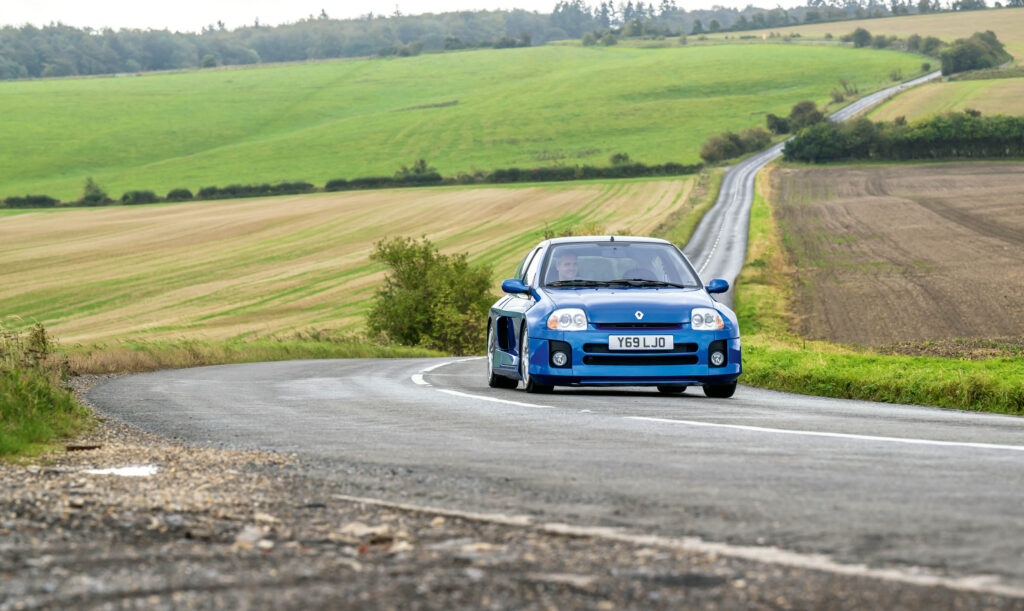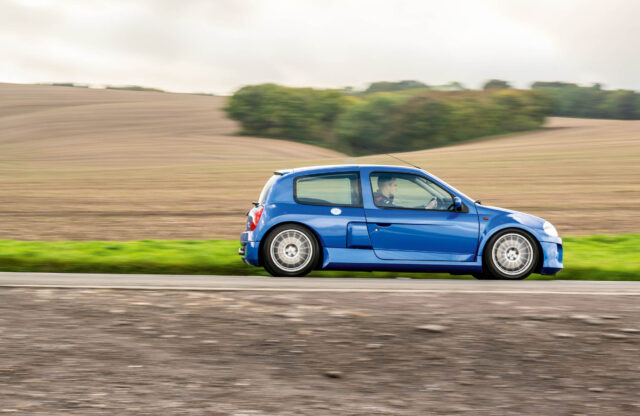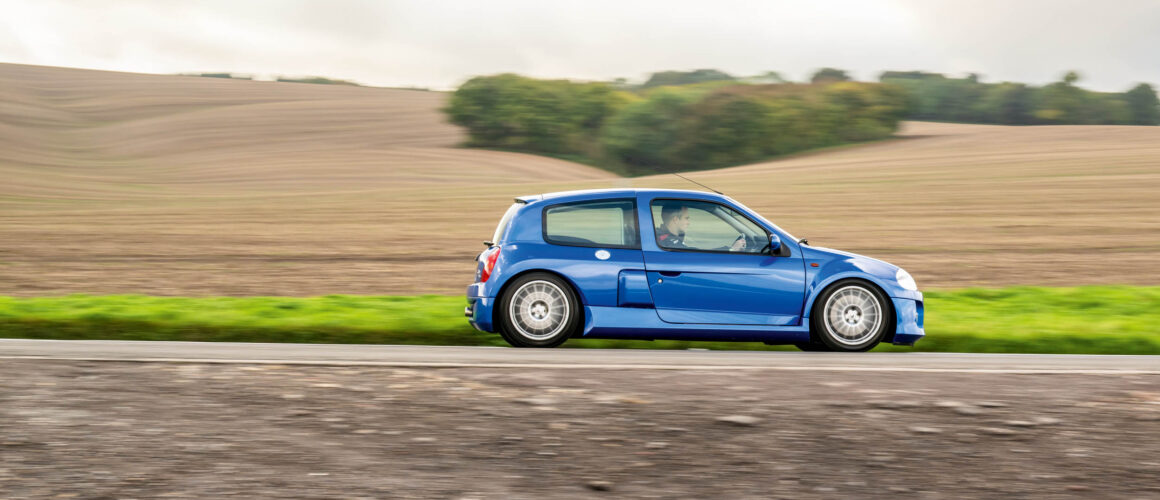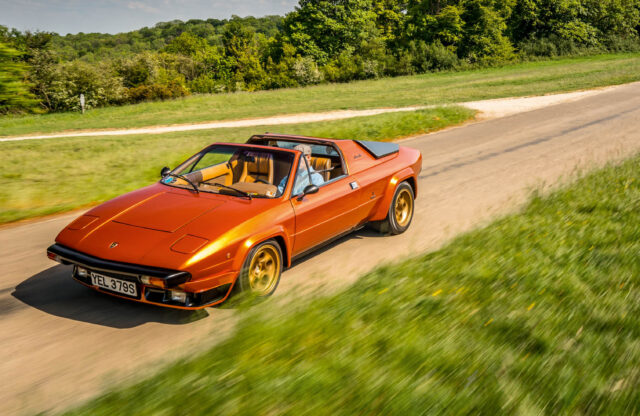Tom Walkinshaw Racing turned RenaultSport’s Clio V6 from mad mid-engined concept into production reality. And this one belonged to the man himself
I’m driving Tom Walkinshaw’s own car, and it’s a Renault. Maybe it’s an age thing but, for me, Tom Walkinshaw Racing, and the man who gave the company his name, will always form a mental association with the Jaguar brand: the Group A XJ-S, the Group C and IMSA cars, the XJR-15 project and, of course, the XJ220. If you grew up in the 1980s, and felt invested in the subsequent glory they attained, how could it be any other way?
Yet Tom and TWR, and later the TWR group of companies, had digits in a great many pies, from Rovers to Nissans and even F1, the latter being what in 2002 brought TWR to its knees. And perhaps the firm’s greatest legacy in road cars is not a commercially troubled hypercar before the term was even invented – or the Volvo C70, for that matter – but the unique French superhatch that is the Clio V6. It was TWR that took the V6 concept and turned it into a production car, and if one example is more evocative than all the others it is surely this car, gifted to Walkinshaw on the 25th anniversary of his company.

The Clio V6 story is one of imagination, entente cordiale, and the kind of product-led decision-making that seems hard to find in the modern-day automotive industry. In the late 1990s Renault wanted a new racing car for its one-make series, replacing the RenaultSport Spider, which as a road car had not been a great sales success. At the same time, a Renault designer had been sketching for fun the idea of a hatchback with a crazy powertrain. Initially this involved putting an F1-spec V10 into a Twingo, in the manner of the Espace F1, but by 1997 it had morphed into the idea of creating a mid-engined Clio in the spirit of the original Renault 5 Turbo. Unveiled at the 1998 Paris motor show, the ‘Trophy’ racing car was accompanied by a concept for a road car, and the reception to it was overwhelmingly positive. Emboldened, Renault called on TWR’s engineering know-how to undertake a feasibility study on what it would take to turn the concept into a fully fledged road car.
By the Spring of 1999 all the Trophy racing cars had been built and the season was underway, their engineering and construction having been handled by RenaultSport and the French engineering and composites firm, MOC. However, Renault lacked the capacity to engineer and manufacture the V6 as a road car, and asked TWR to move ahead with the project; by the summer it had committed fully to both left- and right-hand-drive versions of what would become known as the RenaultSport Clio V6 230.
I can recall pre-production V6s blasting around the Oxfordshire countryside during the year 2000, close to TWR’s HQ, and the effect of seeing one never lost its potency – part of which was sheer incredulity that a mainstream volume manufacturer really was going to bring such a fabulous, frivolous, unique product to market. There’s that old industry joke that VW thought the idea of a 3.0-litre hatchback was based around economy, and so built a Lupo with suitably lightweight materials that could achieve 100 kilometres using only three litres of petrol; meanwhile, the French take was much more in line with Renault UK’s contemporary ‘Va va voom’ marketing strategy…

Actually manufacturing the Clio V6 would prove to be one grand mal de tête. Assembly was to take place at a plant in Uddevalla, Sweden, jointly owned by TWR and Volvo, but every V6 started life as a regular Clio hatchback ’shell built in France. Once in Sweden, significant chunks of the central and rear sections of floorpan were cut out, and a bespoke subframe, tail section and wheel-well structure were welded in. The Swedish plant struggled to paint the glassfibre panels, so initially only silver was offered.
That’s the first unusual thing that stands out about Clio V6 chassis number TOM00001: it’s Iliad Blue, a gorgeous hue normally associated with the beaky-nosed Phase 2 cars that were launched in 2003. If you look very carefully indeed you might notice that the side pods on each flank differ very slightly from one another, one being of pre-production specification. It’s a hint that not all is as it seems.
Walkinshaw’s V6 started out as an early production Clio V6 bodyshell but, rather than being mated with the engine designated to be dropped amidships, it was instead packed off to TWR in the UK. This we know thanks to research carried out by Duncan Powell, the man behind ClioV6.net. Records show that it was built about the same time as the early Phase 1 press cars, but that it was painted outside the factory in blue; silver is still visible in the engine bay, and areas under the front bonnet are black rather than colour co-ordinated.

Once in the UK, the car was assembled in TWR’s engineering workshops, which probably explains why many of its constituent parts are pre-production items subtly different to those of the regular production V6s – the assumption is that they simply had them to hand. Clio V6 specialist Scott Glander at SG Motorsport confirms that items such as the gearbox are of the early type, along with the boot lock, and that the spring platforms have two positions, as if at one time they were used to try out differing ride heights. As the car had never officially been handed over to Renault, the original VIN number was covered over by a new TWR chassis number: TOM00001.
It also had a twin sister, identical in colour but left-hand-drive, and between them it appears they were used as a basis for a factory customisation programme that didn’t go ahead – or at least not until the ‘ID’ programme that saw many a Phase 2 model painted (very expensively) in fancy colours and fitted with interior upgrades. There is one other V6 said to have had this prototype interior – a yellow left-hand-drive pre-production car – but it is known to have been crushed.
In a press release dated 27 February 2001, accompanying the Geneva motor show, Renault announced that its new baby would have a ‘personalisation programme’. With the left-hand-drive Illiad Blue car (sister of TOM00001) on the stand, the release talked about unique trim and fabrics, an aluminium handbrake lever and a smaller steering wheel. Noting the new paint, it also mentioned a sports suspension option and 17in OZ Racing wheels.

Perhaps because the Phase 2 Clio was already on sale before the Phase 1 V6 even reached UK customers in the summer of 2001, Renault never did get around to offering these options, instead concentrating on building 1513 cars in the Swedish plant. Only eight Phase 1 production cars came to the UK in Illiad Blue, while the motor show car is said to be in Renault’s collection but has never been seen again…
Let’s be honest: the Clio V6 has a notoriety that comprehensively envelops it. It’s just one of those cars that you instinctively know not to mess with, in part due to the fundamental physics at play – Renault’s 3.0-litre, quad-cam V6 mounted well back in a relatively short wheelbase – but also because the Phase 1 wasn’t developed dynamically to the level it perhaps should have been. That was largely due to the incredibly short timescale of the project; and, to be fair, the multitude of changes made to the Phase 2, particularly the heavily revised rear subframe, tamed the beast significantly. Nevertheless, add into the mix a very limited steering lock, and you have a recipe for carnage if you’re not on top of your game.
Oh, but it does look fantastic. Truly, madly, deeply awesome. A caricature of a hot hatch, but so beautifully done. To my taste the Phase 1 is more of a looker than the more overtly aggressive Phase 2, and it’s also a slightly different character, too. Not only is it a trickier customer, but it’s more of a GT – and this in a car that’s often misunderstood anyway. You see, with the V6 you need to forget about the illusion the car tries to sell you about a Noughties revamp of the Group B rally formula. Neither is it a hot hatch on steroids. With 227bhp pushing along 1335kg, and all the challenges the driver faces of not firing the car off into the scenery, on a B-road it wouldn’t really see which way a well-driven Clio 172 hot hatch from the period went. But that’s not the point – in fact, that wasn’t what Renault wanted at all. It saw the V6 as half race car, half grand tourer. After the flop of the bare-bones Spider, this time the intention was a comfortable, usable machine as well as a pure flight of fancy. Ironically, it has minimal luggage capacity to play such a role, but the reality is that it excels at it all the same.

All that is in my mind as I close the door behind me and survey the early Clio 2’s curvy, almost toy-like interior. One of the great contradictions of the V6 has always been the incongruous mix of junior supercar with the same dash and trim as a French shopping trolley, and as much as I feel nostalgic for this era of individualistic Renault design under Patrick Le Quément, you can see why some potential customers of the time kept their chequebooks hidden. The extra aluminium details now look a bit crude, but the richer fabrics are welcome and, most of all, the leather-clad Sport Spider bucket seats sit you 50mm lower than the standard bar stools. It makes a tremendous difference to the driving experience, for no longer do you feel on top of the car but rather immersed within it.
The V6 has a lusty, rich woofle at idle, always close right behind your ears, and, while it lacks the top-end urgency of the phase 2 255 model, it isn’t as blunt as I was expecting. It’s all about the mid-range torque, which gets the V6 cutting through the Oxfordshire countryside with effortless, long-legged pace. The steering is slower than you’d imagine and a little vague around the straight-ahead, but the gearshift is surprisingly delicate and the ride remarkably pliant: all V6s are really mini-GTs, but the Phase 1 is the more so.
The great joy is that it constantly talks to you, in the unique way only a car of this layout can, and driving it well is a constant and satisfying challenge. There is never a dull moment with a Clio V6, whether you’re listening to it, looking at it, or behind its wheel. TOM00001 popped up on eBay back in 2008 with just 2000 miles on the clock, and TWR (or what was left of it) was asking for £10,000. Duncan remembers many V6 enthusiasts steering clear, worried that it had sat at head office for a long period of time doing nothing. Eventually it was bought by an enthusiast who used it as a daily driver, and who also attended V6 get-togethers, where the unique details and special story of the car’s past began to emerge. Via a pair of collector owners, it passed to Greg Evans at Contemporary Classics, where it is for sale, now with a still-modest odometer reading of 14,100 miles.
When TWR’s assets were liquidated in 2003, most of its cars (of all types) were sold off, but somehow the V6 remained with the man himself. Given that Walkinshaw passed away in 2010, we’ll never know exactly what the Clio meant to him, whether it simply slipped through the liquidators’ net or if, in fact, he was rather fond of it and what it stood for. TWR might always make me think of Jaguar, but when it comes to road cars its greatest legacy may well be this unlikeliest of French sporting heroes.
Thanks to Contemporary Classics
2001 RenaultSport Clio V6 230 specifications
| Engine | Mid-mounted 2946cc V6, DOHC per bank, fuel injection |
| Power | 227bhp @ 6000rpm |
| Torque | 221lb ft @ 3750rpm |
| Transmission | Six-speed manual, rear-wheel drive |
| Steering | Rack and pinion |
| Front Suspension | MacPherson struts, coil springs, telescopic dampers, anti-roll bar |
| Rear Suspension | Multi-link, coil springs, telescopic dampers, anti-roll bar |
| Brakes | Discs |
| Weight | 1335kg |
| Top Speed | 147mph |
| 0-60mph | 6.4sec |




